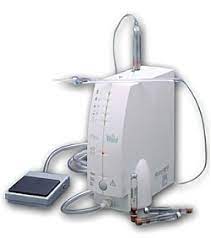No More Needles!
Electronic dental anesthesia offers an alternative to local anesthetic injections, providing dental pain control in procedures such as a tooth filling or dental cleaning without requiring a shot from a traditional needle. The most common way of applying this technique is through a system called Transcutaneous Electrical Nerve Stimulation.
TENS uses a battery-powered unit about the size of a pocket radio. This unit is attached to a control box, which allows the patient to select the level of anesthesia they desire. In a study of patients and their pain following dental surgery, about 7 out of 10 patients reported that using TENS provided good pain relief.
The TENS system was designed for testing the tolerance of chronic pain patients prior to implanting spinal electrodes. Though it was intended only to test patients’ tolerance to electrical stimulation, it turns out that many of the patients experienced such relief from the TENS treatment itself, and that the implant was never needed.
There are numerous advantages to the use of electronic dental anesthesia and the TENS system in particular. One of the major benefits is not having to administer an injection. Another is allowing patients to control the level of anesthesia they receive. Patients can leave their appointment and go back to normal with none of the residual numbness or slurred speech typical of conventional topical anesthesia. And lastly, the electronic anesthesia method eliminates any worries about allergies. Some patients can have severe reactions to certain anesthetics, but with electronic anesthesia, no anesthetic is given — it’s all done with low-voltage electricity.
How Does Electronic Anesthesia Work?
Electronic anesthesia is a therapy that uses low-voltage electrical current for dental pain relief. Scientists don’t fully understand how it works, but studies have shown that it does reduce pain. This may be because the electrical impulses scramble the pain signals sent by the nerves to the brain. Another theory is that the way the electricity interacts with the nerves may help the body produce endorphins, our body’s natural painkillers.
Experts regard the electronic anesthesia technology to be safe and reliable. However, it’s important that the equipment not be misused. For instance, the electrodes must never be used near the eyes, mouth or temples. Moreover, it is advised that patients inform their doctor if they are receiving any sort of alternative therapy, or if they are considering using a combination of electronic anesthesia and alternative therapy.

